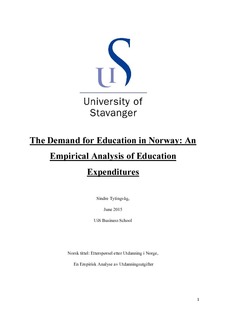| dc.contributor.author | Tytingvåg, Sindre | |
| dc.date.accessioned | 2015-09-08T10:19:55Z | |
| dc.date.available | 2015-09-08T10:19:55Z | |
| dc.date.issued | 2015-06-15 | |
| dc.identifier.uri | http://hdl.handle.net/11250/299040 | |
| dc.description | Master's thesis in Economic analysis | nb_NO |
| dc.description.abstract | The complex development of a country’s economic situation with various components affecting it in many different ways may lead to important changes as a result of a shift in one or more important factors. Allocation of scarce resources is crucial for so many different agents in all sorts of markets. Important decisions will have to be made by an individual, a firm and a corporation, and this chain of decision making leads all the way up to the central government of a country. One of these factors that might seem simple at first, but is indeed very wide is the demand for education in a country. In general, the demand for education shows not only the quantity of education demanded, but also what kind of human capital is being demanded in a labor market by certain firms.
In this thesis, the demand for education has been estimated by using an existing framework that conducts analyses of individual demand through government and private education expenditure. The analysis is conducted by using income, defined as real GDP and government revenue, and the price of education as the important explanatory variables. Data for income and price estimates are collected from both national and international statistics sources, with the use of cross-sectional data from 2012 for most of the income variables and time series data for price and income variables in the time period of 1997-2012. The main objective of this analysis is to estimate income and price effects that can explain the ratio of education expenditures to GDP.
The results does not yield any estimated income or price elasticity that are applicable to explain the total education expenditures in Norway for any of the estimation methods using the two-step analysis. The same outcome results from a time series regression of total demand for high education splitting the analysis into a government and a non-government (private) component that is aggregated in the analysis, but it does show evidence for a positive and small income elasticity that does result in a small impact on total demand for education. Aggregative analysis shows that the income elasticity of 0.238 while the price elasticity is
-0.121, so in sum the aggregate analysis suggests that education is a normal good. It is not possible to explain the education spending to GDP ratio through the government component of aggregate demand, but the private component yields an income elasticity of -0.884 and a price elasticity of -0.372. This suggests that private education is an inferior good (not a Giffen good), but the available data for private education are considered too uncertain to conclude this. | nb_NO |
| dc.language.iso | eng | nb_NO |
| dc.publisher | University of Stavanger, Norway | nb_NO |
| dc.relation.ispartofseries | Masteroppgave/UIS-SV-HH/2015; | |
| dc.subject | økonomi | nb_NO |
| dc.subject | administrasjon | nb_NO |
| dc.subject | økonomisk analyse | nb_NO |
| dc.subject | economic analysis | nb_NO |
| dc.subject | economics | nb_NO |
| dc.subject | business administration | nb_NO |
| dc.subject | demand for education | nb_NO |
| dc.subject | education in Norway | nb_NO |
| dc.subject | education expenditure | nb_NO |
| dc.subject | utdanning i Norge | nb_NO |
| dc.subject | utdanningsutgifter | nb_NO |
| dc.subject | etterspørsel etter utdanning | nb_NO |
| dc.title | The demand for education in Norway: An empirical analysis of education expenditures | nb_NO |
| dc.title.alternative | Etterspørsel etter utdanning i Norge: en empirisk analyse av utdanningsutgifter | nb_NO |
| dc.type | Master thesis | nb_NO |
| dc.subject.nsi | VDP::Social science: 200::Economics: 210::Economics: 212 | nb_NO |
